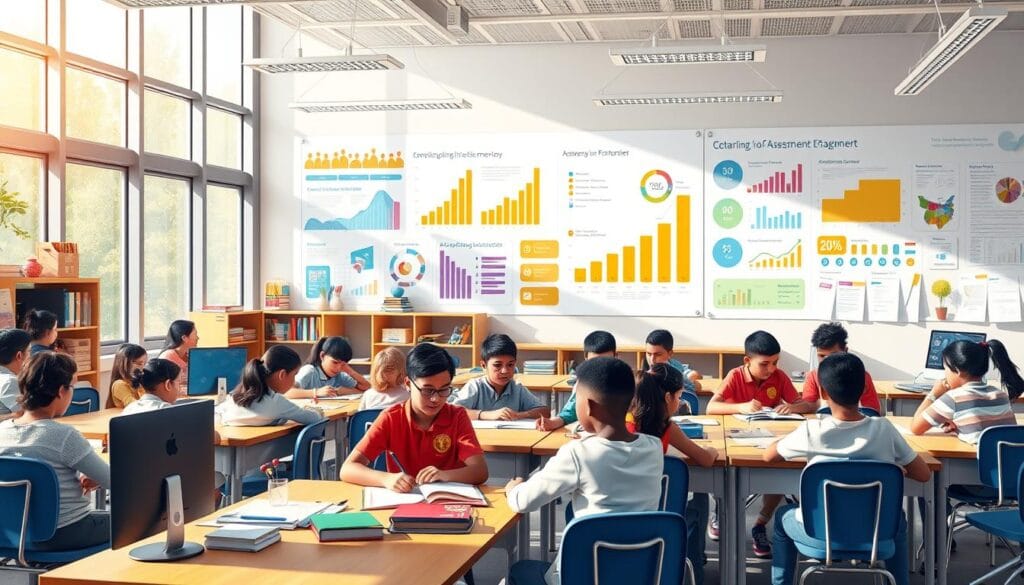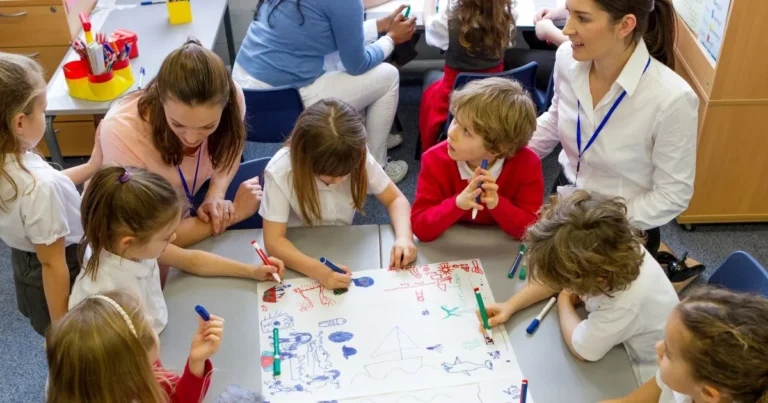What is the Biggest Indicator of Student Success? Powerful Insights and Analysis
When I first stepped onto a college campus, I was overwhelmed. The journey of academic achievement seemed complex. My experiences showed me that success is not just about grades. It’s about personal growth, staying strong, and getting the right support.
Looking at success isn’t just about grades anymore. Modern studies say success includes doing well in school, growing personally, and looking good for the future job market. Places like Georgia State University show this, having boosted graduation rates by over 70% since 2008.
Success in school is not just about grades. It’s about growing as a person and doing well in life. Research by Anthony Carnevale shows that getting a bachelor’s degree can lead to better health and a stable family. This shows how education can change lives in big ways.
Table of Contents
Key Takeaways
- Success is more than academic grades
- Personal growth matters as much as performance
- Support systems play a crucial role in student achievement
- Career potential is an important success indicator
- Resilience and adaptability drive student success
Understanding the Core Components of Student Success
Student success is a complex landscape shaped by many factors. In today’s dynamic educational environment, understanding these core components is crucial for institutions and learners alike.
The school environment plays a key role in determining student outcomes. Research shows that comprehensive support systems and quality instruction are essential for success in schools.
Defining Academic Achievement Metrics
Academic achievement is more than just grades. Modern metrics now include a broader view of student growth:
- Retention rates
- Graduation progression
- Post-graduation employment
- Personal development indicators
The Role of School Environment
A nurturing school environment greatly impacts student performance. Relationship-building with peers and instructors is a key success driver.
“Education is not the filling of a pail, but the lighting of a fire.” – William Butler Yeats
Impact of Support Systems
| Support Service | Impact on Student Success |
|---|---|
| Academic Advising | Increases graduation predictability |
| Counseling Services | Improves mental health outcomes |
| Peer Mentorship | Reduces student isolation |
| Early Intervention Programs | Boosts retention rates |
By focusing on holistic student support, educational institutions can create strong pathways for growth.
The Critical Role of School Culture and Climate
Your school’s culture and climate play a huge role in how well students do. Studies show that a positive school setting can really change how well students learn. Schools with a supportive vibe see big boosts in student interest and grades.
What makes a school environment stand out includes:
- Emotional safety and support
- Inclusive classroom interactions
- Mutual respect among students and staff
- Consistent positive reinforcement
Research shows how big of a difference school culture makes:
| Cultural Factor | Positive Impact |
|---|---|
| Student Engagement | 20% increase |
| Student Behavior Improvement | 75% of educators report positive changes |
| Student Retention | 30% higher with support systems |
Creating a nurturing school environment requires intentional strategies that prioritize student well-being and academic growth.
“School culture is the invisible force that shapes student potential” – Educational Research Institute
By building strong relationships and supporting students, schools can achieve great things. Your effort in creating a positive school climate boosts student motivation and success. It’s all about making a difference in how students learn and grow.
What is the Biggest Indicator of Student Success: Teacher-Student Relationships
Understanding the deep bond between teachers and students shows a key to success in school. This bond is more than just teaching. It’s a key driver of how well students do in school.
Studies show that good teacher-student relationships can change learning for the better. When students feel supported and valued, they learn more. They also stay motivated and improve their skills.
Building Meaningful Connections
To build strong bonds, teachers need to:
- Personalize interactions with each student
- Show real interest in students’ lives
- Be empathetic and understanding
- See each student’s unique potential
Communication Strategies
“The art of teaching is the art of listening” – Unknown
Good communication means:
- Listening well
- Giving helpful feedback
- Creating safe spaces for talking
- Using respectful and encouraging words
Trust and Academic Performance
Research shows trust is very powerful. It says teacher support is the strongest factor in making students feel they belong. When students trust their teachers, they do better in school.
Studies show students with strong teacher bonds can read up to 60% better. They also feel more confident in their learning.
Socioeconomic Factors and Academic Performance

Your child’s success in school is tied to their family’s wealth. Studies show big differences in school results based on how much money families have. About 19% of kids in the US live in poverty, which hurts their grades a lot.
“Opportunity is not created equal, but education can be a great equalizer.” – Educational Equity Advocate
What helps students succeed varies by their family’s wealth. Important things include:
- Parental encouragement and involvement
- Access to educational resources
- Quality of early childhood education
- Household stability
- Nutritional support
Here are some key facts about how money affects school grades:
| Socioeconomic Indicator | Academic Performance Impact |
|---|---|
| Parental Encouragement | 70-90% of students receiving As or Bs report strong parental support |
| Poverty Level | Children from lower-income families tend to achieve lower grades |
| Early Intervention Programs | Significant positive impact on long-term academic success |
Schools and communities can help by starting special programs. Factors for success in schools now include helping students in many ways, not just grades.
Knowing these facts helps teachers, parents, and leaders make schools fairer. They can help every student reach their full potential, no matter their family’s money.
The Impact of Grading Practices on Student Achievement
Grading practices are key to student success and readiness for school. How teachers measure learning affects motivation, engagement, and school results.
Recent studies offer deep insights into how we assess students. A 2019 study found that high school grades predict college and career success better than tests. This shows the value of detailed evaluation methods.
Norm-Referenced vs. Mastery-Based Grading
Traditional grading methods often miss the mark. Here’s why:
- Norm-referenced grading pits students against each other
- Mastery-based grading looks at each student’s growth
- Clear signs of success come from focused assessments
Equity Considerations in Assessment
Grading can unfairly block some students’ paths. Studies reveal:
- A-F grading raises student stress
- Punitive tests lower student interest
- Emotions greatly affect how well students do in school
Alternative Evaluation Methods
“Traditional grades do not motivate students to perform better nor enhance learning outcomes,” says education researcher Chris Hulleman.
New methods are being tried to tackle these issues:
- Feedback-first assessment models
- Competency-based evaluations
- Holistic scoring that looks at progress and effort
By changing how we grade, teachers can make learning environments more supportive. This way, we can better measure how ready students are for school.
Student Engagement and Motivation Patterns
Understanding what drives students is key to their success. High school students who are actively engaged do much better in school. They outperform those who are not as motivated.
Student engagement has three main parts:
- Behavioral Engagement: Showing up to class and finishing homework on time
- Emotional Engagement: Building good relationships with teachers and friends
- Cognitive Engagement: Putting effort into thinking deeply and learning
“Motivation is the spark that transforms potential into performance.” – Educational Research Insights
Schools can use advanced analytics to keep an eye on how motivated students are. Modern systems give real-time data on how students are doing. This helps teachers spot and help students who might be losing interest.
| Motivation Factor | Academic Impact |
|---|---|
| Family Motivation | Positive correlation with success outcomes |
| Academic Expectations | Strong positive influence on achievement |
| Course Content Interest | Directly linked to learning outcomes |
Using strategies like personalized learning and special support can really help. By focusing on what each student needs, teachers can make learning more effective.
The Role of Basic Needs Security in Academic Success
When students face basic survival needs, their school success drops. Socioeconomic status greatly affects a student’s school performance. Basic needs security is key for doing well in school.
In 2022, over 17.3% of households with kids struggled to get enough food. This is more than just a number—it blocks their chance to do well in school.
Food and Housing Security Challenges
Students with unstable basic needs find it hard to learn. The McKinney-Vento Homeless Assistance Act helps by protecting their right to education.
- Over 30 million children could benefit from the Summer Electronic Benefit Transfer Program
- National School Lunch Program provides critical nutritional support
- Chronic absenteeism is closely linked to housing instability
Access to Critical Resources
Support isn’t just about food and a place to live. Students also need healthcare, technology, and study materials. These things help them succeed in school.
“Basic needs security is not a luxury—it’s a fundamental prerequisite for learning.” – Education Equity Expert
Support Programs and Solutions
New ways are being found to help. The American Rescue Plan-Homeless Children and Youth (ARP-HCY) funding is a big help for students who need it most.
| Program | Focus | Impact |
|---|---|---|
| Summer EBT | Child Nutrition | Supports 30M+ children |
| McKinney-Vento Act | Housing Rights | Ensures educational access |
| ARP-HCY Funding | Comprehensive Support | Targets underserved populations |
By focusing on basic needs, schools can make learning fairer. This helps students reach their highest potential in school.
Measuring Academic Preparedness and Growth

Understanding how ready students are for school is more than just looking at test scores. Today, schools use many ways to see how students are doing. They look at how much students have grown and how well they can do things.
Here are some ways to check if students are ready for school:
- Standardized testing
- Growth percentile measurements
- Performance-based assessments
- Comprehensive student portfolios
“Academic growth is about understanding where a student starts and how far they’ve progressed, not just their final destination.” – Education Research Insights
The California School Dashboard is a new way to track how ready students are. It uses many different measures to show how well students are doing. These measures include:
- Test score performance
- Attendance rates
- Social-emotional learning progress
- College readiness indicators
Value-added models are also important for checking if students are ready. These models look at how much students have improved over time. They help teachers see how each student is doing on their own path to learning.
New studies show that mixing numbers with personal feedback is key. With technology, schools can now give students help that really fits their needs. This makes sure students get the right support to grow.
Data-Driven Approaches to Student Success Analytics
Today’s schools are changing how they help students with new data tools. They use analytics to turn data into useful information. This helps them spot and stop problems early.
Data analytics helps schools understand how students are doing. By looking at different data, teachers can make plans that fit each student’s needs.
“Data is the new language of education, speaking volumes about student potential and challenges.”
Effective strategies include:
- Tracking how well students are doing
- Warning systems for early help
- Plans made just for each student
- Keeping an eye on how things are going
Success in schools now depends on advanced tools. These tools help:
- Find students who might need extra help
- Make learning fit each student
- Use resources wisely
- See if plans are working
Schools look at important data like:
| Data Category | Purpose |
|---|---|
| Academic Performance | Track learning progression |
| Attendance Patterns | Predict potential dropout risks |
| Engagement Metrics | Assess student motivation |
Success with data needs both tech and human touch. It’s about helping students in a complete way.
Conclusion: Creating Pathways for Sustainable Student Achievement
Success for students means more than just good grades. It involves a mix of school climate, community involvement, and learning plans tailored to each student. Your educational journey is a journey of growth and change.
The U.S. Department of Education says success is not just about test scores. Programs like service learning help students learn important life skills and build confidence. Schools can make a big difference by offering strong support and personalized learning spaces.
Studies show that a positive school environment boosts learning and grades. Success requires teamwork from teachers, school leaders, families, and community groups. Your dedication to supporting students can make a big difference in their education and personal growth.
As education changes, we must stay flexible and meet students’ evolving needs. By focusing on their whole development, we can build better learning spaces. These spaces empower students to succeed in all areas of life.








